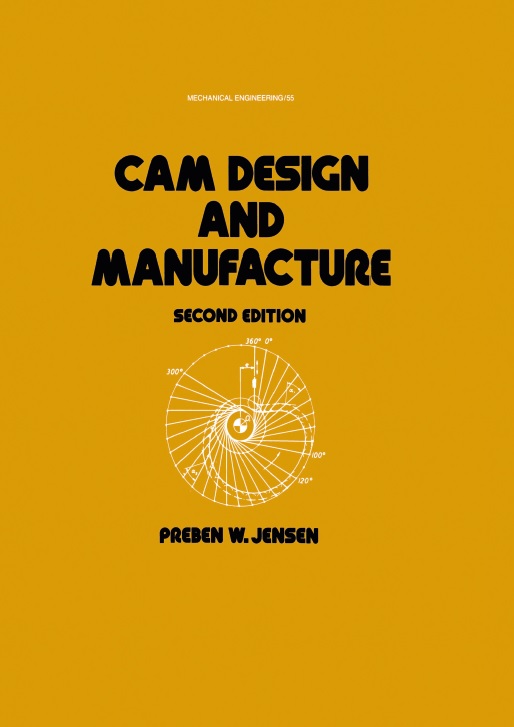Cam Design and Manufacture, Second Edition
By Preben W. Jensen

Contents:
Using the Cam Design Software Vil
Nomenclature IX List of Nomograms XIII
1. Cam and Follower Systems 1
2. Displacement Diagrams 8
3. Displacement Diagram Synthesis 31
4. Cam Profile Determination 46
5. Pressure Angle and Radius of Curvature 75
6. Circular Cams 106
7. Circular-arc and Straight-line Cams 126
8. Forces, Contact Stresses, and Materials 141
9. Methods of Cam Manufacture 159
10. Dynamics of Cam Mechanisms 170
11. Cam Mechanisms 188
12. Velocities, Accelerations, and Dynamic Forces in Linkages and Cam Mechanisms 206
13. Computer Programs for Analysis and Synthesis of Cam Mechanisms 252
Bibliography 321
Index 425
Preface:
This book was written to give the practicing engineer a sound grasp of the methods of solving the problems connected with cams-their design, application, and manufacture. The above goal is as valid for this new edition as it was for the first edition. Since that time the most important change has been the improvement of numerically controlled machine tools (NC-machines) and the availability of computers in general. Therefore the emphasis on graphical and analytical methods has shifted toward the latter; but for a design engineer who has put his creative thoughts into metal it is of the utmost importance that he can visualize the problems; therefore the graphical approach has not been neglected. Major changes occur in Chapters 5 and 12 where analytical expressions that can be programmed on a home computer have been developed. The plan of the book is as follows: In Chapter 1 the basic types of cam and follower systems are described and illustrated. In Chapter 2 the construction and use of displacement diagrams are explained and formulas are given for the displacement, velocity, and acceleration curves for various types of cam motion. In Chapter 3 displacement diagram synthesis is explained and methods of combining various curves to obtain a desired motion are given. Chapter 4 outlines the methods of determining cam profiles graphically when different types of followers are used and formulas for determining the cam profile using both rectangular and polar coordinates are given.
Chapter 5 takes up the importance of pressure angle, and the procedure for proportioning a cam with respect to pressure angle limitations is explained. The importance of avoiding too small a radius of curvature is also discussed.
In Chapter 6 the advantages of circular cams and methods of proportion-ing these are outlined.
Chapter 7 continues with a discussion of circular-arc and straight-line cams, which have advantages particularly from the standpoint of ease of production. Chapter 8 considers the important factors of forces, contact stresses, and materials. This is followed in Chapter 9 by a discussion of various methods of cam manufacture. When cams rotate at high speed, the factors of elasticity and backlash must be taken into consideration if the desired accuracy of motion is to be obtained. One way of doing this is to use the polydyne method of cam design. In Chapter 10 this method is described in detail and the effect of various members of the cam train are determined. In Chapter 11 the use of various types of mechanisms with cams to offset the disadvantages of the latter is illustrated with various examples. In Chapter 12, formulas to determine velocities, accelerations, and forces in linkages have been developed. This chapter together with Chapter 8 should enable the reader to find forces in complex mechanisms other than cam mechanisms. Chapter 13 includes six computer programs that allow the user to determine minimum cam size for given maximum pressure angles for eight different cam displacement diagrams and calculate the maximum com-pressive stress by both rise and return for translating as well as swinging roller followers. My thanks to Mr. A. F. Abou-Ghaledum from Cleveland State University, who in no time linked the six programs together to make them user-friendly. Twenty-eight nomograms are included in order to facilitate computa-tions. The bibliography at the end of the book lists more than 1800 titles in English and German. The list in the first edition comprised “only” approximately 500 titles. The list is in alphabetical order and is referenced in eleven groups to facilitate its use. An author usually puts a little of his heart and convictions into his book and I am happy to express that the first edition was well accepted.
